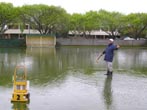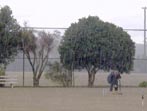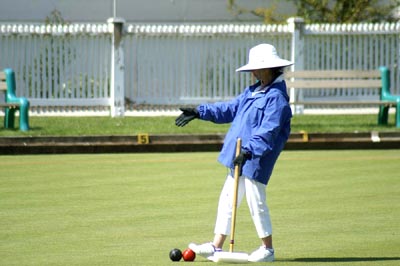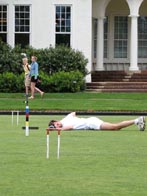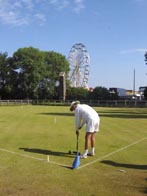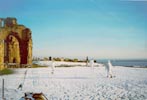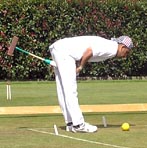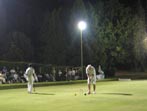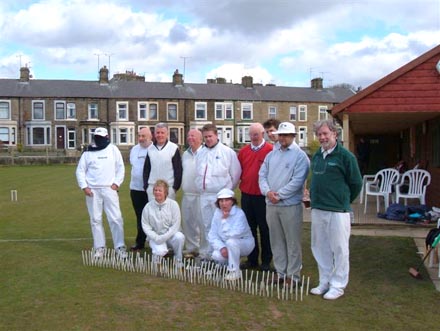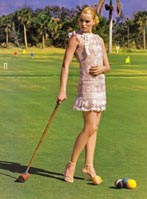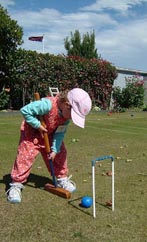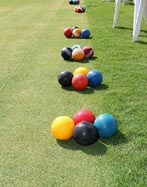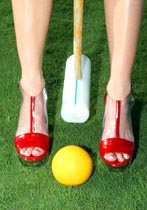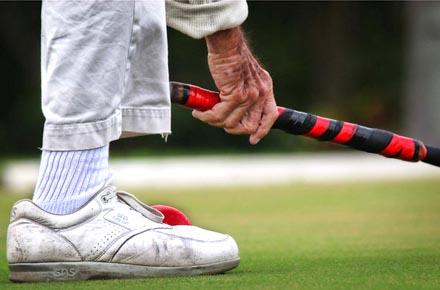

|
Back to |
| The Front Page |
| Letters & Opinion |
|
Croquet World applauds the winners in our 2007 photo contest |
|
text by James Hawkins; compilation of photos by Bob Alman; layout by Reuben Edwards
|
Croquet publications in all media are constantly clamouring for fresh artwork, and each of the sport's national governing bodies needs an endless supply of stock photographs for publicity. To encourage better croquet photography and for our own considerable amusement, we have now concluded Croquet World Online's second photography competition. It is our intention to make the contest a recurring feature. The culture of photographing croquet events needs to be nurtured and encouraged. Many players take cameras to tournaments with good intentions, only to be sidetracked into playing the game. Too often, the sole images captured are a succession of smiling face-forward prizewinners proudly displaying their newly earned trophies. If only that period of creativity could start while players remain on the lawns! Here we present our pick of the best croquet-themed pictures submitted to our second photo contest.
In a break from other awards ceremonies, we start with a single overall winner. There's no prize, but the title goes to Joe Camosy, who gives us this exceptional image.
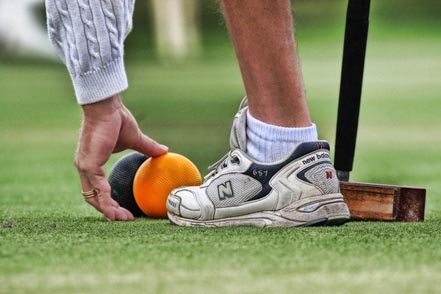
|
It often takes an outsider to look with a dispassionate eye at the game. Camosy - a friend of our American editor who was invited to take pictures at the National Croquet Center but who is not, himself, a croquet player - has given this close-up an almost abstract quality, an insight that may come more naturally to those with a fresh view of their subject. He's not a paid professional, but he clearly possesses a confident knowledge of digital image processing. PhotoShop is the best friend of the modern photographer, and the winning picture has undergone some enhancement to polish it to perfection.
| About the contest and reprint permissions |
|
All the photos in this contest and article belong to the photographers and are published here by permission. They are reproduced here in low-resolution form suitable for the Web, but most are available in higher density from the photographer. If you wish permission to reprint, contact the photographer directly. Just click to "2007 Photo Contest Images" to view all the qualifying photos for this year, and click to "2006 Photo Contest Images" to view the photos from the 2006 contest.
Click on the images for a larger view. A new window will open.
|
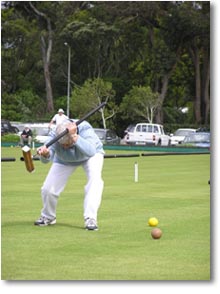
|
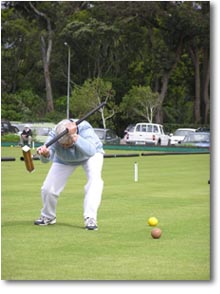
|
BEST WEATHER PHOTOS
BEST HORIZONTAL PHOTOS
An unceasing source of inspiration comes from croquet players' enthusiasm for lying face down in damp grass. This has given rise to a new category this year: Best Lying Down and Lining Up Photograph.
BEST VENUE PHOTOS
The importance of a photograph's background is often overlooked. The far distance becomes the main subject matter in this next shot, joint runner-up in the Venues category.
BEST ACTION PHOTOS
Action photos are always difficult in croquet. Most playing styles prevent the photographer from seeing the subject's face at the same time as the outcome of a shot.
THE MISCELLANEOUS CATEGORY
As last year, there are a number of images, which fit into none of the other categories.
ART SHOTS
As is now traditional in the CroquetWorld Photo Competition, Joe leaves empty-handed. There are no prizes for this event, save the opportunity for competitors to share their masterpieces with the rest of us.
We'll be back next year with our third annual photo competition. We can almost guarantee that there'll still be no prize money, but we know that's not going to stop your submissions. As we award ceremony hosts say, it's your contributions that make these competitions what they are, and we look forward to a bumper crop of fresh pictures in 2008. In the meantime, be warned: Next year we may very well change or sharpen the focus of our world-wide search for exceptional photos of our favourite sport.
Using PhotoShop (Version CS2)
One of few photographers in this year's contest to respond to our invitation to send "processed" images as well as unprocessed snapshots was Joe Camosy - a Palm Beach amateur photographer who has won several awards and contests. We asked him to tell us how you and I might process our croquet photos as successfully as he has done with his award-winning contest images. Here's his answer:
1. Examine the composition for impact and crop if necessary. Composition is critical. I use a grid overlay obeying the "rule of thirds" to judge the composition and decide whether and how cropping would improve it.
2. Make global and local exposure adjustments using a curves adjustment layer and layer masking, if necessary.
Copy layer and use the "Lucis Art" PhotoShop plug-in to perform local contrast enhancement, which gives the image a quality of crispness and clarity. I usually used the Wyeth 1 setting with a 20% to 50% blend. This plug-in is "the secret weapon," but it must be applied sparingly! If overdone, it can cause the image to look too "digital", "processed", or worse!
4. Copy the Lucis art layer to a new layer and perform the "gothic glow" PhotoShop action on the layer to obtain a soft, diffuse glow with saturated colors.
Adjust layer opacity and use layer masking to apply the two effects (#3 and #4 above) to various parts of the image in various amounts. The idea here is that we want these two effects to be subtle - to give the image a special quality, but still have it look like an unaltered photograph.
6. Apply a slight vignette to the image as an eye control element to emphasize and subtly direct the eye to the main subject. I do this using a curves adjustment layer with a layer mask.
The gothic glow PhotoShop action is free. Just do a Google search for "gothic glow". The Lucis Art PhotoShop plug-in costs $160 and is available at http://www.lucisart.com.
For serious photography - and for amateurs who are serious about producing good pictures - there is no alternative to PhotoShop. PhotoShop is a must.
